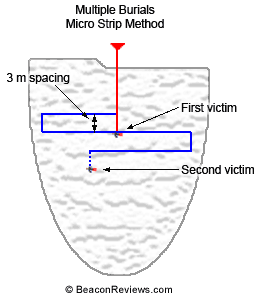This technique is similar to the expanding circle technique in that you search the terrain within 3 meters with the goal of getting very close to the second transmitter. This method is physically easier than the expanding circle technique, because you don't have to walk up hill (which makes this preferable on steeper terrain). Conceptually it is more difficult, because the distance between you and the first victim changes (whereas in the expanding circles, you remain approximately the same distance from the victim as you circle him).
The basic process is to perform a zigzagging signal-search pattern with only 3 meters between the search strips, and then only commit to following your transceiver if it indicates that you are within 3 meters of a transceiver. (Some rescuers suggest using 5 rather than 3 meters; both are good strategies.)

In this example "micro search strip" illustration, the red line shows your initial search path to the first victim. You should then move 3 meters up hill and continue searching, but this time with only 3 meters between your zigzagging search strips.
Your directional indicator will continue to point to the first victim and the displayed distance will increase as you move further way from the first victim.
When you zigzag back, the displayed distance will decrease as expected as you approach the first victim and then increase as you pass the first victim.
When you eventually get closer to the second victim than the first victim (this is the point where the blue line changes to a dotted line in this illustration), your transceiver will point toward the second victim and the distance indicator will decrease to display the distance to the second victim. When the displayed distance is approximately the width of your micro search strips (i.e., 3 meters), you can use the fine search technique to locate the second victim.
As with the expanding circle technique, don't take the displayed distances and direction indicator too literally. It's more important that you watch for a significant, unexpected decrease in the distance that decreases to approximately your search strip (e.g., 3-4 meters). This may also be accompanied by a change in the direction indicator.
It is critical that you understand the concept of the micro search strip technique which is that by making narrow, 3-meter search strips, at some point you will end up closer to the second victim than to the first (and get within 3 meters of the second victim).
Additional details on the micro search strip technique can be found here.